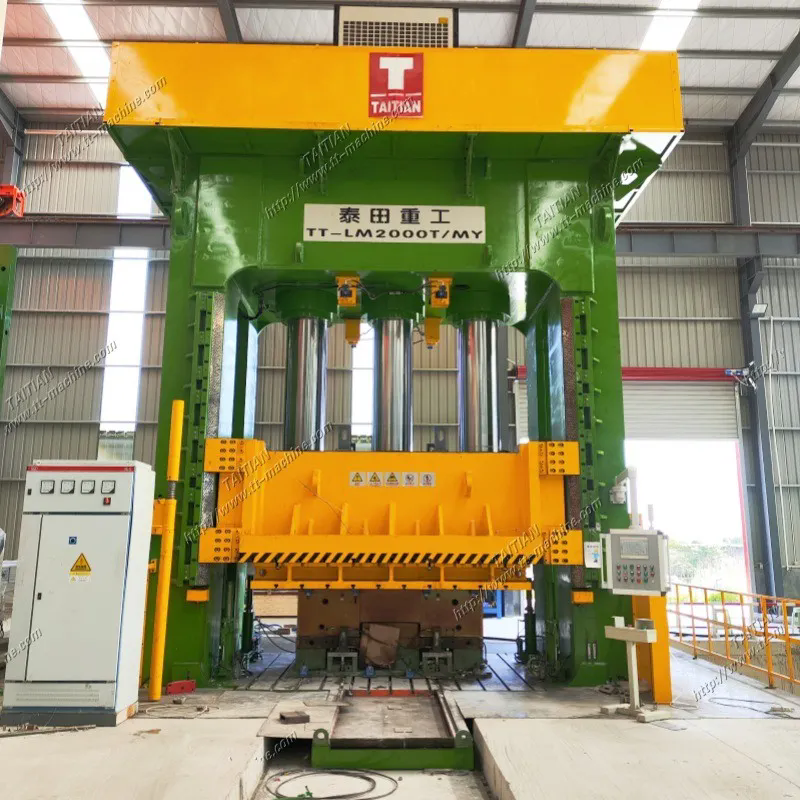Composites Hydraulic Press: Revolutionizing Material Processing and Manufacturing
2024-08-26
In the rapidly evolving world of material science and manufacturing, the composites hydraulic press stands out as a transformative technology. Designed to process composite materials, this advanced machinery offers unparalleled precision, efficiency, and versatility. In this blog, we will explore the features, benefits, and applications of composites hydraulic presses, highlighting their impact on modern manufacturing and material processing.
What is a Composites Hydraulic Press?
A composites hydraulic press is a specialized piece of equipment used to shape and mold composite materials under high pressure. Composites are materials made from two or more different substances that, when combined, produce properties superior to the individual components. These materials often include a matrix (like resin) and reinforcement fibers (such as carbon or glass).
The hydraulic press operates by using hydraulic fluid to generate a substantial amount of pressure, which is applied to the composite material. This pressure is crucial for consolidating the fibers and matrix, ensuring uniformity, and achieving the desired shape and strength of the final product.
Key Features of Composites Hydraulic Presses
1. High Pressure Capabilities: Composites hydraulic presses can generate extremely high pressures, often exceeding 2000 psi (pounds per square inch). This capability is essential for achieving the optimal consolidation of composite materials.
2. Precision Control: Modern hydraulic presses come equipped with advanced control systems that allow for precise regulation of pressure, temperature, and time. This ensures consistent quality and performance of the composite materials.
3. Temperature Control: Many composites hydraulic presses are equipped with heating elements to control the temperature of the press. Temperature management is critical in processes like curing or molding, where specific thermal conditions are required.
4. Large Pressing Area: Composites hydraulic presses often feature large pressing areas to accommodate various sizes of composite materials and molds. This versatility is beneficial for handling different applications and production volumes.
5. Automatic and Manual Modes: These presses can operate in both automatic and manual modes. Automatic mode allows for streamlined, repetitive tasks with minimal operator intervention, while manual mode provides flexibility for custom or complex processes.
6. Robust Construction: Built to withstand high pressures and harsh conditions, composites hydraulic presses are constructed from durable materials such as steel and reinforced alloys. This robustness ensures long-term reliability and performance.
7. User-Friendly Interface: Advanced hydraulic presses feature intuitive user interfaces and touchscreen controls, making it easier for operators to set parameters, monitor processes, and troubleshoot issues.
Benefits of Composites Hydraulic Presses
1. Enhanced Material Properties: The high pressure applied by these presses ensures optimal consolidation of composite materials, resulting in improved mechanical properties such as strength, stiffness, and durability.
2. Increased Efficiency: Hydraulic presses streamline the manufacturing process, reducing the time required for shaping and curing composite materials. This leads to higher production rates and cost savings.
3. Consistent Quality: The precision control features of modern hydraulic presses ensure that each batch of composite material meets consistent quality standards. This uniformity is crucial for applications requiring high performance and reliability.
4. Versatility: Composites hydraulic presses can handle a wide range of composite materials and applications, including those used in aerospace, automotive, construction, and sporting goods industries.
5. Reduced Waste: Efficient processing and molding reduce material waste by ensuring that composites are used effectively and that defects are minimized.
6. Customizable Processes: The ability to adjust pressure, temperature, and time allows for customization of the processing parameters to meet specific requirements of different composite materials and applications.
7. Improved Safety: The robust design and automated features of hydraulic presses enhance safety by reducing the need for manual handling and minimizing the risk of accidents.
Applications of Composites Hydraulic Presses
1. Aerospace Industry: Composites hydraulic presses are used to manufacture lightweight, high-strength components for aircraft and spacecraft. These components include fuselage panels, wing structures, and interior parts.
2. Automotive Industry: In automotive manufacturing, these presses produce parts such as bumpers, body panels, and structural components that contribute to vehicle performance, safety, and fuel efficiency.
3. Construction Industry: Composites hydraulic presses are employed to create durable and lightweight building materials, including panels, beams, and reinforcement components for construction projects.
4. Sports and Recreation: The sports industry utilizes hydraulic presses to produce high-performance equipment such as bicycle frames, tennis rackets, and golf clubs, which benefit from the strength and lightness of composite materials.
5. Marine Industry: In the marine sector, composites hydraulic presses are used to manufacture components for boats and yachts, including hulls and structural elements that withstand harsh marine environments.
6. Renewable Energy: These presses play a role in producing components for wind turbines and other renewable energy systems, where lightweight and strong composite materials are essential for efficiency and performance.
Choosing the Right Composites Hydraulic Press
1. Pressure Requirements: Determine the maximum pressure required for your specific composite materials and applications. Ensure the hydraulic press can meet these requirements.
2. Pressing Area: Consider the size of the materials and molds you will be working with. Choose a press with an adequate pressing area to accommodate your needs.
3. Temperature Control: If your process requires precise temperature control, ensure that the hydraulic press includes the necessary heating elements and temperature management features.
4. Automation Needs: Decide whether you need an automatic press for high-volume production or a manual press for custom or low-volume applications.
5. Durability and Maintenance: Evaluate the construction materials and design of the hydraulic press to ensure it will withstand the demands of your production environment. Regular maintenance is also crucial for long-term performance.
6. Budget and Investment: Assess your budget and weigh the investment in a high-quality hydraulic press against the potential benefits in terms of efficiency, quality, and production capabilities.
Maintenance and Care Tips
1. Regular Inspection: Periodically inspect the hydraulic press for signs of wear, leaks, or damage. Address any issues promptly to ensure safe and reliable operation.
2. Hydraulic Fluid Maintenance: Check and maintain the hydraulic fluid levels and quality regularly. Replace the fluid as needed to prevent contamination and ensure smooth operation.
3. Cleanliness: Keep the press and its components clean to prevent contamination of the composite materials and ensure optimal performance.
4. Calibration: Regularly calibrate the pressure, temperature, and control systems to maintain accuracy and consistency in your manufacturing processes.
5. Operator Training: Ensure that operators are properly trained in the use and maintenance of the hydraulic press. Proper training helps prevent operational errors and ensures safety.
Conclusion
The composites hydraulic press is a critical tool in modern manufacturing, offering unparalleled precision, efficiency, and versatility for processing composite materials. Its advanced features and benefits contribute to enhanced material properties, increased production efficiency, and consistent quality. From aerospace and automotive to construction and sports equipment, composites hydraulic presses play a vital role in producing high-performance components and materials. By understanding the capabilities and applications of these presses, manufacturers can make informed decisions and leverage this technology to drive innovation and success in their industries.



